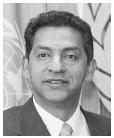ECUADOR
Lucio Edwin Gutiérrez Borbua
President

(pronounced "LOO-chee-oh AID-win goo-TYAIR-ez bore-BOO-ah")
"It is time to send into retirement those old style politicians who have done so much damage to Ecuador."
The Republic of Ecuador is located on the western coast of South America, north and west of Peru and south and west of Colombia. Ecuador has an area of 283,560 sq km (109,483 sq mi). The Galapagos Islands, a famous wildlife sanctuary, are also a part of Ecuador. With a tropical climate in the coastal area, the country also encompasses land in the drier and colder Andean region. Ecuador's highest mountain, the Chimborazo, reaches 6,267 m (19,000 ft) and forms part of the Andes mountain chain that extends from Colombia in the north to Argentina and Chile in the south.
Ecuador is a densely populated country of 13.5 million people (2002 estimate). With about one-third of the land area of Chile, Ecuador's population is almost equal to that of Chile. The capital city, Quito, is located in the Andean region. The Pacific port of Guayaquil, in the coastal region, is equally important for the country's economy. About 65% of all Ecuadorans are mestizo (mixed Spanish and Amerindian), 25% Amerindian, 7% Spanish, and 3% black. Ecuador's population grows moderately at a 2% increase per year, with more than 35% under the age of 15. The infant mortality rate of 33.02 deaths per 1,000 live births (2002) is somewhat higher than most South American nations, but lower than Bolivia and Peru. Life expectancy was 71.6 years in 2002. Approximately 95% of the population considers itself to be nominally Roman Catholic, but practicing Catholics are much fewer in number. Protestant churches have made important gains in recent years, particularly in urban areas.
Ecuador's main natural resources are petroleum, fish, and timber. The country's major exports are primary products, most notably oil, bananas, rubber, coffee, cocoa, cut flowers, and shrimp. The gross domestic product (GDP) in 2001 was US $18 billion, 6.0% higher than in 2000. The GDP was expected to expand by 3.4% in 2002, marking the third year of economic growth after the 1999 recession where the economy shrank by 7.9%. Inflation reached a staggering 96% in 2000, but after the national currency was dropped and Ecuador adopted the U.S. dollar as its new currency, inflation fell to 22.4% in 2001 and 9.7% in 2002. Still, because domestic inflation has risen faster than international prices, Ecuadoran exports are expensive and foreign goods are cheap. In 2002, Ecuador exported US $5.9 billion and imported goods and services for a total of US $7.9 billion. A negative trade balance, despite high oil prices in recent years, has kept the foreign debt at a relatively high level of US $15.9 billion. Ecuador's main trading partners are the United States (37%), other Latin American nations (30%), and the countries of the European Union (EU—20%). Japan and other Asian countries have also entered the Ecuadoran market in recent years, but this trade has not grown as rapidly as in other Latin American nations. While unemployment stood at 8.7% in 2002, underemployment is common in rural and coastal areas.
ADDRESS
Excelentisimo Presidente de la Republica
Palacio Nacional
Garcia Moreno 1043
Quito, Ecuador
Comment about this article, ask questions, or add new information about this topic: